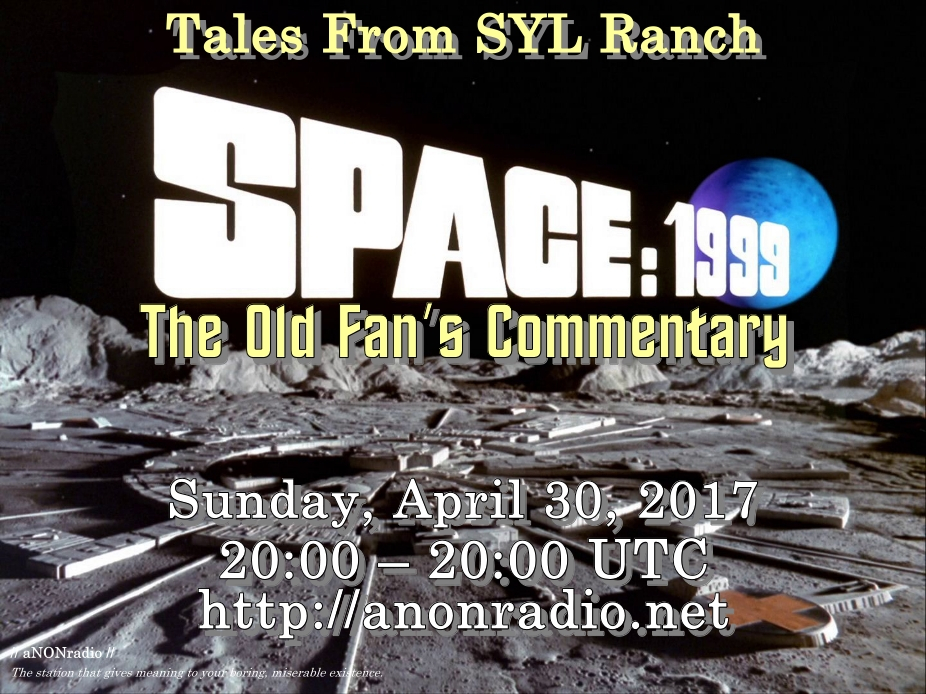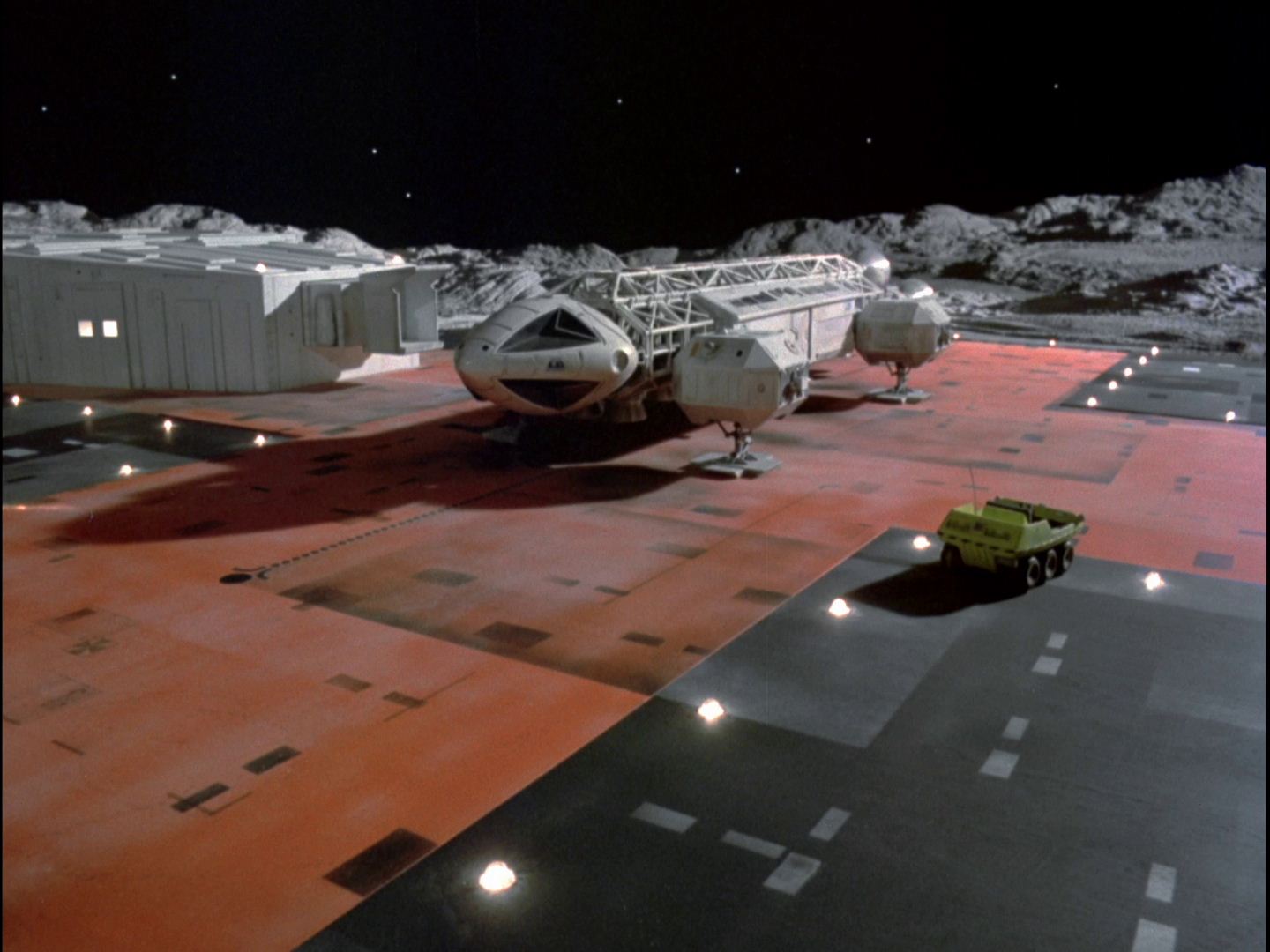The Old Fan’s Commentary On Space: 1999

There’s an Old Fan’s Commentary On Space:1999 this week on Tales From SYL Ranch!
Tales From SYL Ranch can be heard live Sundays, 20:00-22:00 UTC on //aNONradio.net//
We hadn’t planned to do this, but we’re using a new rig and providing additional streaming. Rather than risk it falling to pieces during the Old Fan’s Commentary on Star Wars (Sunday, May 7th and 14th), we decided to test it first on a known disaster.
We’ll only be commenting on one Space: 1999 episode: S01E01 – “Breakaway.” It’s a wonderful example of the show getting many things very, very right — while simultaneously being the dumbest premise ever conceived Spoilers.
Space: 1999 is so schizophrenic that it’s unlikely there will be future commentaries. It’s noteworthy for a few reasons, the most obvious being the then-state-of-the-art special effects. Some Space: 1999 model and effects artists later worked on Star Wars and were part of ILM‘s founding team.

Space: 1999‘s Eagle was extremely detailed and featured a practical, modular design. It’s one of the things Space: 1999 got very, very right. To this day, the Eagle is one of the most revered (and outright coolest) spaceship designs ever imagined. It often appears in the background of other films as an Easter Egg.

A always, the Old Fan’s Commentary will attempt to focus more on what was happening in science fiction fandom at the time rather than interesting tidbits about the film.
As always, we’ll have The Hitchhiker’s Guide To the Galaxy and topical music sprinkled throughout.
To set the stage:
It’s September of 1975. You’re ten years old. You’re a huge Star Trek fan. That in turn led you to SF literature, in particular Larry Niven. In 1973, Niven adapted one of his short-stories, “The Soft Weapon,” into an episode of Star Trek: The Animated Series.
You quickly discovered that “The Soft Weapon” is part of a much larger Known Space universe. Because Niven is a stickler for scientific accuracy, you’ve learned to demand it. In 1975, all science fiction fans demanded it.
Other than Star Trek: The Animated Series, there’s been no science fiction of note — neither in TV nor film — for over five years. There’s a burgeoning Star Trek fan community in the US that’s just finding its legs.
That fan community constantly butts heads with Old Fans. The Old Fans grew up with nothing but literature. They find filmed science fiction to be banal and insipid by comparison.
This absolutely includes Star Trek. In 1975, there was a clear delineation between “real fans” and “Trekkies.”
Through the grapevine, you hear about a new show, Space:1999. It has known stars in the lead roles. Martin Landau and Barbara Bain had starred in Mission: Impossible. Barry Morse had spent four years chasing Dr. Richard Kimball in The Fugutive.
That all sounds good. Production stills begin appearing in certain magazines, and those look good. The models look good, the sets look good, the space suits all look good.
The premise of the series is patently ludicrous. Even a 10-year-old knew that Spoilers.
Those are the things in your mind as you tune in (on low-def broadcast TV).
We’ll be trying a couple of experiments this time around. In addition to the podcast stream of the commentary, we’ll be making a low-res version of the episode available for streaming — but only during the show! If this works, we’ll do the same to the next two weeks’ Old Fan Commentary On Star Wars.
To play the episode, click here:
- SDF.org
- http://wrstone.sdf.org/ofc/
- Be aware that the SDF.org copy will disappear when the show is over.
- YouTube
- https://www.youtube.com/watch?v=redO-zdQjbs
- The YouTube version has so far survived a couple of years without a DMCA notice.
- If you want higher definition, find a legal stream (or an illegal one, just don’t tell me about it).
Sunday’s tracklist:
- “When Twilight Falls On NGC 891”
- Space 1999: “Main Titles”
- Space 1999 – War Games: “Armageddon”
- The Hitchhiker’s Guide to the Galaxy: Primary Phase – Fit the Sixth (S01E06)
- Space 1999: “Breakaway”
- Introduction To the Old Fan’s Commentary On Space: 1999
- The Old Fan’s Commentary On Space: 1999
- Space: 1999: “Theme Montage”
- The Star Wars Holiday Special
“Can we air just twenty minutes of Chewie noises??”
– Jack Packard
What were fans doing in 1975 when Space:1999 premiered? Listen to Tales From SYL Ranch find out!
Tales From SYL Ranch can be heard live
Sundays, 20:00-22:00 UTC on
//aNONradio.net//
[Spoilers]
Why Space: 1999 Has the Dumbest Premise Ever Concieved
You can’t blow the Moon out of orbit.
Seriously, that’s it, right there: the basic premise of the show is ludicrously impossible. Science Fiction fans are the most demanding viewers in existence. If you screw up in such a flagrantly stupid fashion, you’ve probably lost your audience and don’t know it.
The Moon is not a billiard ball that can be knocked off its trajectory by something sufficiently massive. You can’t put a rocket engine on it. It’s so large as to be occasionally classified as a dwarf planet.
If you struck the Moon with sufficient force to knock it out of orbit, that’s not what would happen. Instead, you’d start with a very deep hole. It would get deeper until such time as the Moon itself couldn’t withstand the stress. The Moon would then crack like a gigantic egg — the difference being that it would spew white-hot volcanic rocks the size of other planets’ moons.
If you were lucky, you’d wind up with a few big rocks and change. With more luck, the rocks will stay in the Moon’s orbit, meaning we’d suddenly have pieces of Moon orbiting the Earth in roughly the same spot.
If you weren’t lucky, the rocks would be small. You’d then have a nice, new asteroid belt around Earth in former Moon’s orbit.
In either case, risk of extinction by Moonrock becomes very likely. Regardless, there will be Earthquakes, tornadoes, tsunamis, tidal waves, and tectonic/volcanic eruptions. The tilt of the Earth could change.
Worse is the location location of the explosion. The writers keep referring to “the dark side of the Moon” as though that’s meaningful. In fact, the “dark side” of the Moon isn’t dark. It’s just the side of the Moon not facing Earth.
The Moon’s orbit and rotation are such that only one side of it faces Earth. Until the Space Age, astronomers didn’t know what the other side of the Moon looked like. They called it “the dark side” to indicate that it was a big blank spot on the map.
That means is that they were dumping nuclear waste as far from Earth as possible — which is a good idea from a radiation standpoint. It was an idea that had been bounced around in science fiction since Hiroshima and Nagasaki.
However, if you hit the Moon with force sufficient to knock it out of orbit, you’re doing so on the face exactly opposite Earth. The aforementioned massive, white-hot volcanic rock would come spewing straight at Earth.
Earth-bound disasters are hinted-at in the episode, but not enough thought was given to it. People would die by the billions. Civilization might be reduced to the Stone Age or worse.
The idea of the Moon blowing out of orbit is galactically stupid.
That doesn’t even begin to touch the faster-than-light speeds the Moon would require to reach another planet every week.
Space: 1999 is very schizophrenic. On the one hand, there are the many things it gets right. Unfortunately, it’s in the service of a laughable premise; often featuring plots with no internal logic.
“It’s sci-fi, anything can happen, so who needs to explain it?” seems to have been the writers’ motto.
An Exclusive Look Inside SYL Ranch Studios

Always know where your towel is.